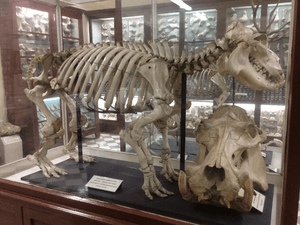Hippopotamidae facts for kids
Quick facts for kids Hippopotamidae |
|
|---|---|
 |
|
| Hippopotamus amphibius | |
| Scientific classification | |
| Kingdom: | |
| Phylum: | |
| Class: | |
| Order: | |
| Family: |
Hippopotamidae
|
Hippopotamuses are a group of very large mammals. They are known for their huge bodies, short legs, and love for water. These amazing animals belong to a special group called the Hippopotamidae family. Today, there are only two living species of hippos left in the world.
Contents
What Makes Hippos Special?
Hippos are truly unique animals! They are very large, with short, strong legs and bodies shaped like barrels. Their heads are huge, with wide mouths and nostrils placed right on top of their snouts. This helps them breathe easily when most of their body is underwater.
Hippo Feet and Walking
Just like pigs, hippos have four toes on each foot. But unlike pigs, all four of a hippo's toes touch the ground when it walks. Hippos walk on their toes, which is called being "unguligrade." Most animals that walk this way have hard hooves, but hippos don't. Instead, they have tough, padded feet that help them move around.
Hippo Skin and Digestion
Hippos have smooth skin without much hair. They don't have the same kinds of glands that make oil or sweat like humans do. Their outer skin layer, called the epidermis, is quite thin. This means hippos can dry out very quickly if they stay out of the water for too long. That's why they love to spend most of their day in rivers and lakes!
Hippos eat plants, and their stomachs have three parts. Even though they have a special stomach, they are not true ruminants, which are animals like cows that chew their cud.
Hippo Teeth
Hippos have very impressive teeth! Their front teeth, called incisors, and their pointed teeth, called canines, are large and look like tusks. The canine tusks are much bigger and continue to grow throughout the hippo's life. The teeth at the back of their mouths are large and complex. These are perfect for grinding up all the plants they eat.
Hippo Family Tree

The study of how living things are grouped together is called taxonomy. Scientists group animals based on their shared features and history. The Hippopotamidae family includes the two types of hippos we see today:
- Family Hippopotamidae
- The common Hippopotamus (Hippopotamus amphibius)
- The Pygmy Hippopotamus (Hexaprotodon liberiensis or Choeropsis liberiensis)
The pygmy hippo is much smaller and lives mostly in forests, while the common hippo is larger and spends more time in water.
See also
 In Spanish: Hipopotámidos para niños
In Spanish: Hipopotámidos para niños


